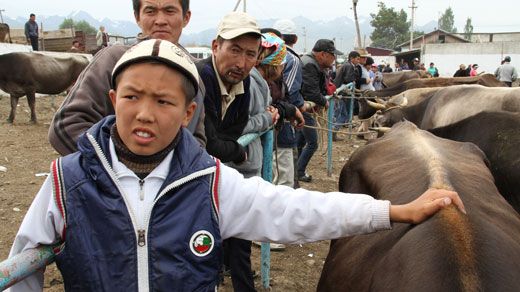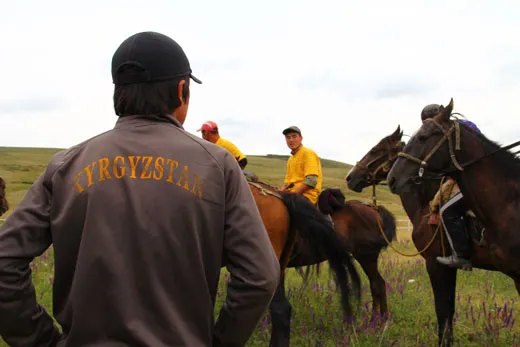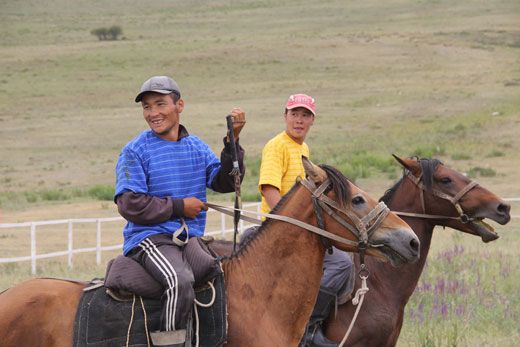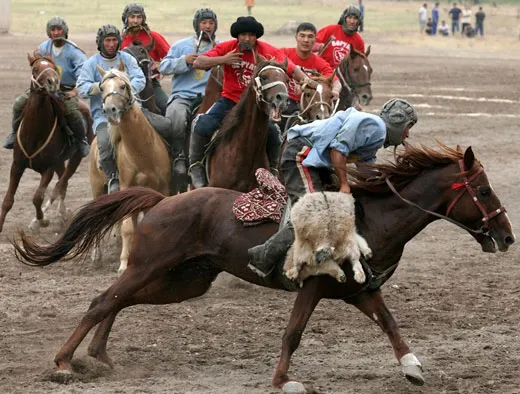Kok-Boru, the Horse Game You Won’t See at the Olympics
In Kyrgyzstan, traditional horse games offer a glimpse into Central Asia’s nomadic past
/https://tf-cmsv2-smithsonianmag-media.s3.amazonaws.com/filer/horse-games-Kyrgyz-631.jpg)
Five autumns ago, on a quiet Monday afternoon in Barskoon, a village on the shores of Issyk Kul Lake in eastern Kyrgyzstan, Ishen Obolbekov was lounging in his backyard yurt when he heard what sounded like the clackety clack of horse hooves smacking asphalt.
The noise appeared to grow louder.
Obolbekov, who is six feet tall and cuts an urbane figure, walked outside and saw the snow-capped Ala-Too Mountains that tower above his village. Then he watched as about a dozen horse-mounted teenage boys stormed his front yard and presented him with a headless goat.
They didn’t need to explain. Obolbekov, 49, co-owns a horse-trekking company and hails from a family of shepherds. He knew the teens had come to re-enact the post-game ritual that traditionally accompanied kok-boru– “blue wolf” in the Kyrgyz language – a popular horse game in which two teams of riders face off in a field and attempt to carry a goat or calf carcass into the opposing team’s end zone. Obolbekov says the game may have evolved from informal competitions among shepherds who hunted wolves that threatened their flocks.
Times have changed, but variants of the game are still played across Central Asia under several names, such as ulak-tartysh in other regions of Kyrgyzstan, kokpar in Kazakhstan and buzkashi in Afghanistan.
The young men at Obolbekov’s gate had just won a kok-boru match, and they hoped their host would honor tradition by giving them a prize. A century ago, a typical kok-boru prize would have been a feast, but today it can be cell phones, televisions or even a Mercedes Benz, according to Obolbekov. He gave those teen riders bread, sweets and the equivalent of $100.
“The Kyrgyz people used to be nomadic, and the horse was our closest friend,” Obolbekov told me. “Horse games are the way we show our identity and traditions.”
He was speaking on a scorching summer afternoon at a bus station in Bishkek, the Kyrgyz capital. I had traveled to the land-locked ex-Soviet republic to find out why kok-boru and other horse games are so important to Kyrgyz people, and what today’s games teach us about the pre-Soviet era, when millions of people across Central Asia were nomadic shepherds who depended on horses for basic survival.
I squeezed into a crowded minibus as it rattled east toward Issyk Kul Lake. Kyrgyzstan is slightly smaller than South Dakota, and its mountainous landscape reminded me of the Rockies. But instead of the farmhouses of rural America I saw yurts – the circular, portable homes that have for centuries helped nomads survive harsh Central Asian winters.
Six hours later, the minibus rolled into Barskoon, Obolbekov’s hometown, and I checked into a family guesthouse staffed by his wife and brother. The next morning I hired a taxi headed for Jolkolot, a village where the community-based tourism company CBT Kyrgyzstan had organized a one-day horse games festival.
My driver dropped me at a grassy pasture overlooking Issyk Kul Lake and the looming Ala-Too Mountains. Camera shutters clicked as roughly a hundred foreign tourists watched young men from a nearby village don jerseys, lace riding boots and adjust their horses’ saddles.
A goat was then decapitated, signaling the start of a kok-boru match.
Not everyone is impressed by the sport. Ashley Fruno, senior campaigner for the Virginia-based animal rights organization People for the Ethical Treatment of Animals, calls kok-boru an example of “sadistic savagery.”
“While this game may have had its place in the middle ages, we must not forget that it’s now 2011,” Fruno told me in an email message. “England has already banned fox-hunting, Spain is banning the bullfight, with the lesson being that pastimes involving cruelty belong in the past - as they are games of shame that spotlight callousness rather than skill.”
But the nomadic tribes that once roamed Central Asia slaughtered animals to mark important occasions. Traditional nomadic customs here are to some extent disappearing as people migrate to cities, but in many Kyrgyz and Kazakh households animal slaughters are still symbolically important and coincide with weddings, birthdays and religious festivals.
In Jolkolot, once the goat carcass had been hauled to midfield, the horsemen began racing around, cracking bullwhips and trailing clouds of dust. Yaa! Yaa! they yelled. The horses charged, scattering tourists. For more than an hour, the headless goat moved across that pasture with such vigor that I nearly forgot it was dead.
Some westerners liken kok-boru to polo, but in Jolkolot I pictured a hybrid of rugby and a Texas rodeo. Cynthia Werner, a cultural anthropologist at Texas A&M University, says the game appeals to horsemen – not horsewomen – across Central Asia who thrive on danger. Kok-boru is particularly dangerous, she adds, because players must shift their weight frequently as they lunge for and carry the goat, “which is not a light object.”
“Polo is also dangerous,” says Werner, who has watched horse games live and on television in Kazakhstan. “But in polo you’re just holding a stick.”
Kok-boru is the iconic Central Asian horse game, but there are other popular horse-related activities. At the festival in Jolkolot village, I watched demonstrations of the games oodarysh and kyz-kuumai.
Oodarysh – “to take down” in the Kyrgyz language – is essentially horse-mounted wresting. Nomadic young men in pre-Soviet Central Asia once played the game as a means of preparing for war. Eye-poking and finger-breaking is prohibited, but Oodarysh gets rough and rowdy. As I watched two young men spin around on their horses trying to upset each other’s centers of gravity, I marveled at how horses appeared to highlight the primal ties binding man and beast.
Kyz-kuumai – “catch the girl” – is a mock courting ritual in which a man and a woman chase each other on horseback. The competitors have vastly different objectives: His is to catch and kiss her, while hers is to lash him with a whip. Festival organizers couldn’t find a Kyrgyz woman wiling to play, so they recruited Inès Beyer, a German expatriate who has lived and worked in the area. Beyer was friendly in conversation, but once she started tearing across the field on her horse – and swinging her whip – I was happy to not be in her way.
CLACKETY
CLACKETY
CLACK.
The man looked over his shoulder.
CRACK!
“At first you think you don’t want to hit him,” Beyer, 30, recalled afterwards as she struggled to catch her breath and stop laughing. “But when you’re in the game … you do!”
***
These horse games may be entertaining, but they also illustrate darker aspects of Central Asia’s recent past. Scholars say Soviet authorities maintained a complicated relationship with people in Kyrgyzstan and other Soviet satellites. Although Moscow allowed the Kyrgyz people to practice some of their centuries-old nomadic customs, they also pushed collectivized agriculture. Many Kyrgyz and Kazakhs resisted collectivization in the 1930s by destroying their herds or driving them into neighboring China.
Soviet officials “selected traditions that would strengthen the identity of the Soviet regime,” says Erica Marat, a professor at American University who grew up in Bishkek. “So whatever we understand today about the importance of horses and horse games for the Kyrgyz is what the Soviet Union made locals learn about themselves.” Under Soviet rule, horse games were often played as part of a Moscow-directed “Shepherd’s Day” fair and accompanied by propaganda events, and the ancient nomadic custom of long-distance horse racing was modified so that some races were held, Soviet-style, in stadiums.
Unfortunately, Soviet authorities also contributed to the decimation of the native Kyrgyz horse – another marker of nomadic identity – by cross-breeding it with weaker European horses, according to Jacqueline Ripart, a French expatriate whose Bishkek-based Fondation Kyrgyz Ate works to protect surviving herds of the ancestral horses. Of the more than two million Kyrgyz horses roaming present-day Kyrgyzstan in the late 19th century, Ripart says, only a handful have survived.
After Kyrgyzstan declared independence in 1991, Kyrgyz authorities attempted to promote nomadic heritage – notably by including a representation of a yurt on the national flag and promoting Manas, the horse-mounted protagonist of an eponymous epic poem, as the Kyrgyz national hero. But they still haven’t made a broad-based effort to revive cultural activities that many Kyrgyz people associate with their past, says anthropologist Erica Marat. Kyrgyz elites are typically Russian-educated, she explains, and they view horse games and other markers of nomadic identity as “backward and uncool.”
But according to scholars, nomadic culture has been making comeback in Kyrgyzstan since the early 1990s. More Kyrgyz people are spending time in their yurts, listening to traditional Kyrgyz music, studying the Kyrgyz language (rather than simply speaking Russian, as they did under Soviet rule) and breeding horses, scholars say. The return to old ways isn’t always culturally motivated: In a country where about one in five are unemployed, many have turned to shepherding and other nomadic customs as a means of survival. Others have taken a renewed interest in traditional sports, music and arts in order to market the activities to tourists.
Ishen Obolbekov, the horse-trekking guide who arranged my trip to the horse games festival in eastern Kyrgyzstan, says he’s happy to celebrate the old nomadic ways even if their contemporary iterations aren’t perfectly authentic. “Of course horse games have been commercialized, but this is our history and our past,” he says. “If we stop playing them, our children might ask, ‘Father, did your father play internet games?’ Tourists also want to know who the Kyrgyz people are and what a nomad is. Horse games are the proof.”
***
From Jolkolot, I caught a bus to Barskoon, Obolbekov’s hometown, and then a shared taxi to Bishkek, the leafy Kyrgyz capital.
In the spring of 2010, demonstrators stormed Bishkek’s presidential palace, toppling the president. Violence also engulfed the country’s restive south, killing more than 400, according to the New York-based advocacy group Human Rights Watch. Although a new president, Almazbek Atambayev, was elected last November, Kyrgyzstan remains unstable. International rights groups accuse the government of abusing ethnic Uzbeks, and United States and Russia are perennially vying for control of the country’s military bases, one of which is a key strategic outpost for the American-led NATO war in Afghanistan.
But as I strolled through Bishkek’s central square last summer, the place felt peaceful. Children played in a central fountain ringed by yellow flowers as street vendors sold kumiss, a traditional drink made from fermented mare’s milk, and construction workers tinkered on a nascent statue of Manas, Kyrgyzstan’s horse-mounted national hero.
Ishen Obolbekov was waiting for me near the construction site in sunglasses, a polo shirt and starched khakis. He led me across the square into an upscale café, where a menu advertised caviar and a flat-screen television blasted American music videos.
“So,” he said over a raucous Eminen song. “How was the festival?”
Good, I said, although it was a shame that no career shepherds had participated or attended. I knew the festival had been tourist-oriented, but if horse games are so popular in Kyrgyzstan, wouldn’t a handful of shepherds have jumped at the chance to watch live kok-boru?
Obolbekov chuckled.
“In the summers, shepherds go into the mountains,” he said. “They’re busy!”
Mike Ives is a writer based in Hanoi, Vietnam. His website is www.mikeivesetc.com.



